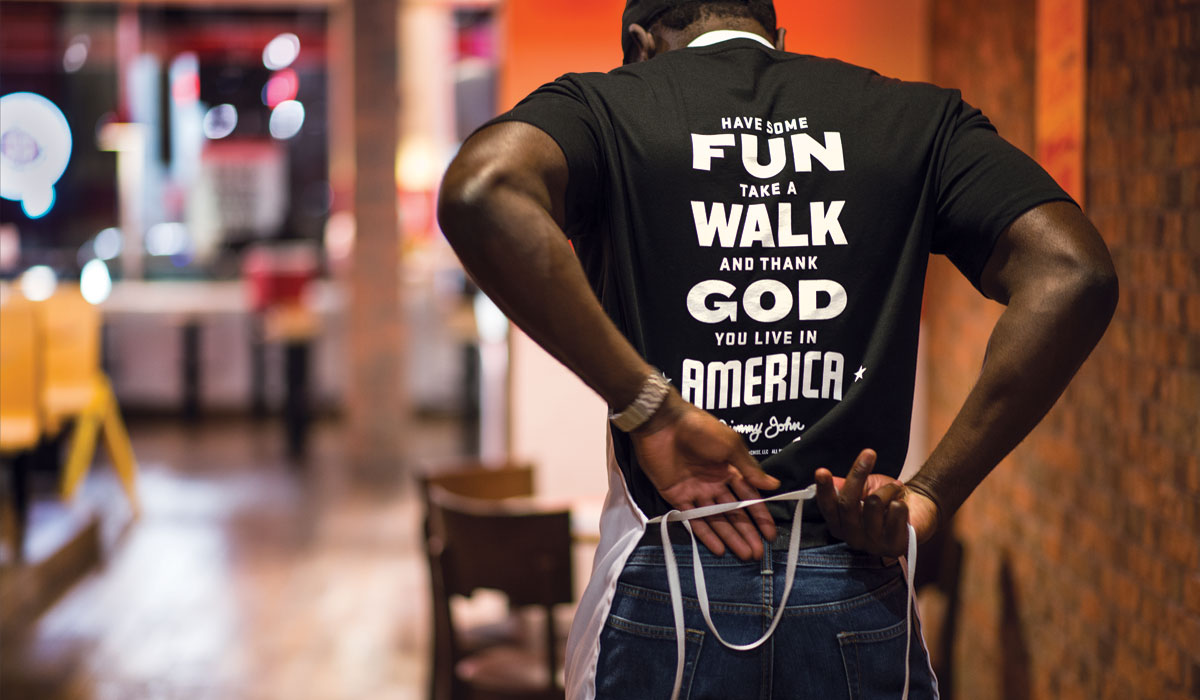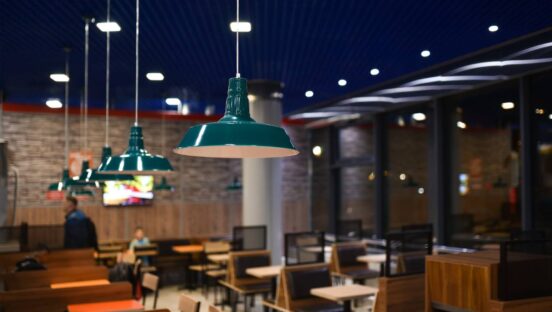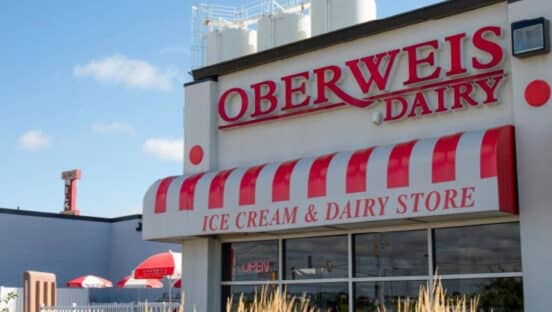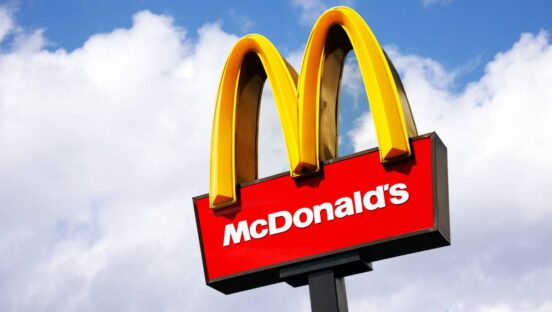On a recent phone call, James North lets out a chuckle and confesses he has a rather freaky story to share.
Back in 1998, North, having just finished college, traveled some 7,500 miles from his native New Zealand to Alaska. There, on the other end of the world, North found himself sharing a cabin and riding ATVs with a fast-talking, eccentric, Illinois-bred entrepreneur incessantly boasting about the world’s greatest gourmet sandwiches.
“His personality was huge,” North says today of his chance encounter with Jimmy John Liautaud, the founder of Jimmy John’s. “So huge that I was a believer before I even tried the sandwiches.”
Before leaving Alaska, Liautaud invited North to work for his growing restaurant enterprise, one then hurtling toward 100 stores, many of them scattered around college towns in the Midwest. Though flattered, North initially dismissed the offer.
“It seemed crazy,” North says. “Why would I come to America to make sandwiches?”
But, buoyed by his own adventurous spirit and Liautaud’s unabashed boldness, North eventually changed his mind. Months later, he navigated his way to Champaign, Illinois, home to the flagship University of Illinois campus. Directed to work in a Champaign storefront, North says he was relieved when Liautaud told him the store’s operating hours were “10 to 3.”
“This will be easy,” North thought of the presumed five-hour window, failing to realize, of course, that Liautaud, who built his sandwich empire by being bold and distinctive, meant 10 a.m. to 3 a.m.
On his first shift, North endured a 12-hour, 5 p.m. to 5 a.m. grind that perfectly represented the always enterprising, sometimes irreverent world Liautaud had created, one characterized by door-to-door delivery of $4 sandwiches with catchy names like The Vito Geneveso and The Pepe, and a store that teased guests with “free smells.”
Now, 21 years later, North remains with Jimmy John’s, its president since 2004 and its CEO for the last five years. He could have never envisioned this ride back in 1998.
“Jimmy John has a special talent for taking ordinary people and pushing them to do extraordinary things,” he says of his larger-than-life, long-time boss. “That’s really the secret sauce to Jimmy John’s.”
And it’s that secret sauce that North and his fellow Jimmy John’s leaders are now working to pour over the entire Jimmy John’s system, a 2,800-unit enterprise eager to cement its standing as an industry powerhouse amid a quick-service environment seemingly growing more competitive, challenging, and complex by the day.
Acting in “different ways”
The modern quick-service world is a vastly different one than Liautaud encountered in 1983, the year in which the eventual Eastern Illinois University dropout launched his sandwich concept in Charleston, Illinois.
Back then, containing inebriated college students was among the biggest challenges Liautaud faced, so much so that he hired a bouncer for his flagship location. Today, however, with stores across 43 states, an army of franchisees, a performance-driven majority owner in Roark Capital Group, and myriad competition—both in the sandwich category as well as in the delivery space, one of Jimmy John’s long-held domains—the challenges are much more complex.
“We’ve got more competition than ever before, and it’s coming from everywhere,” North acknowledges.
Over the last two years, such present realities have fueled some uncommon steps for Jimmy John’s, a concept almost religiously focused on simplicity for the better part of its 36-year existence. The company has unveiled new menu items to appease diners, tested new technology aimed at enhancing the guest experience, and altered its media program to further spread the Jimmy John’s “Freaky Fresh! Freaky Fast!” gospel.
“This environment forces you to react in different ways,” North says.
Consider the menu, one largely unchanged throughout the last two decades—an unapologetic ode to streamlined operations and a “freaky fast” promise to make sandwiches in 30 seconds or less.
“The whole system is set up to help people make a 30-second sandwich, to execute with speed and precision,” North says, pointing to kitchens devoid of fryers, steamers, and other peripheral equipment, as well as a menu defined by one cheese and seven meats. “Inside stores, it’s all about the hustle, and we do things faster and better than anyone else.”
Since last summer, however, Jimmy John’s has carefully expanded its menu, rolling out its 16-inch Giant size (double the size of its original sandwich) and introducing a new 9-Grain Wheat sub. The company also added new condiments: sliced pickles and a Kickin’ Ranch sauce made daily with fresh buttermilk, puréed hot cherry peppers, and seasonings.
And earlier this year, Jimmy John’s unveiled its first-ever grab-and-go sandwich, the 13-inch, Parisian-inspired Frenchie, to inject even more convenience and speed into the operation. In a clever marketing play that captured headlines, Jimmy John’s followed up The Frenchie’s launch with a $30 limited-release pinot noir designed to pair with the salami, capicola, and provolone sandwich.
Jimmy John’s shined a spotlight on its menu changes, as well as its employees’ gusto for making gourmet sandwiches, with its “Freak Yeah” national television campaign. Launched last summer, the tongue-in-cheek, documentary-style spots featured real Jimmy John’s restaurant staff—so-called “freaks” —carefully slicing lettuce to 3/32 of an inch, crafting the brand’s new Kickin’ Ranch sauce in the restaurant’s open kitchen, and inspecting fresh-baked bread in the oven.
The ordinary doing the extraordinary, as North would call it.
“We focused on our employees because we see them as a huge competitive advantage for us,” says chief marketing officer John Shea, a former Gatorade executive who joined Jimmy John’s in 2017.
To capture more scale and efficiency with its media buys, Jimmy John’s placed its “Freak Yeah” ads nationally, veering from its traditional market-by-market advertising approach.
“As we continue growing, the biggest opportunity is to raise awareness, especially as we move into places not as familiar with Jimmy John’s,” Shea says about the shift to a national media strategy.

“We’re all about keeping the customer in focus and working on ways to wow them. The things that separate us—speed, freshness, quality of food—have us well positioned for consumer trends, so we’re going after it.” — John Shea, chief marketing officer at Jimmy John’s.
Clutching the fast and fresh promise
As its “Freak Yeah” campaign notes, Jimmy John’s doesn’t conceal its core focus: a relentless push to be fresh and fast. And freakishly so.
“Being fast and fresh is central to Jimmy John’s, and that’s what we innovate off,” Shea says.
Wanting to get consumers in and out quickly and to serve as an efficient part of their day, Jimmy John’s continues embracing technology to enhance and expedite the guest experience. Last October, the company unveiled tap-and-go as well as mobile payment options, such as Google Pay and Apple Pay, to foster faster, frictionless transactions. In addition, Jimmy John’s continues tweaking its mobile app and online ordering to improve speed.
“We want the lowest number of clicks between our customers and their sandwich, and are always looking to take out the fluff,” Shea says, adding that the company’s roots on college campuses, including a corporate headquarters that remains in Champaign, keeps Jimmy John’s engaged and nimble. “College students tend to be at the front end of tech trends, and they want a frictionless experience on their terms, something that works for them. It’s our job to deliver that.”
Jimmy John’s unwavering attentiveness to its fast and fresh brand promise has also led the company to double down on delivery, a longtime brand differentiator that has come under attack in the age of third-party delivery agents like Uber Eats, DoorDash, and Grubhub.
As Jimmy John’s assessed its response to the rise of third-party delivery, leadership noted “big gaps between consumer expectations and what they get,” Shea says, including delivery times extending beyond 60 minutes. Reflecting on its own assets—namely speedy in-store prep, a network of some 45,000 delivery drivers, 5-minute delivery zones, and a 36-year run perfecting delivery—Jimmy John’s quickly determined it could do delivery better than anyone else. That spurred the brand to proclaim that it would never use third-party delivery.
Those services aren’t fast enough, nor fresh enough, Shea says.
“Freaky fast is our standard because the faster we get it to the customer, the fresher it is,” he says, touting Jimmy John’s average delivery time of 18 minutes. “It’s clear customers care about speed of delivery, cost, and quality, and we win on all of these.”
The trick, Shea adds, is to continue that winning, especially as consumers show growing interest in the convenience of delivery and welcome a growing assortment of choices.
“Delivery in 18 minutes is a competitive advantage, but if it slips to an hour, then that advantage disappears, so we have to be on top of our game more than ever,” Shea says. “We want to be leaders in delivery, period. It’s a differentiator for us and, even more than that, true to who we are as a brand.”
Charging ahead
Propelling Jimmy John’s recent innovation is Roark, the Atlanta-based private equity firm that purchased a majority stake in Jimmy John’s three years ago in a deal that reportedly valued the sandwich chain at $3 billion.
A prominent name in the restaurant world, Roark has invested millions in notable restaurant names, including Arby’s, Buffalo Wild Wings, CKE Restaurants (Carl’s Jr. and Hardee’s), Corner Bakery Café, and FOCUS Brands concepts such as Auntie Anne’s, Cinnabon, and Moe’s Southwest Grill. Today, Jimmy John’s is leveraging Roark’s industry knowledge to fuel its growth.
“There’s really nothing we encounter that they haven’t seen before, and that’s a real advantage as we try to continue growing the Jimmy John’s brand,” North says of Roark.
After years of running the Jimmy John’s business on little more than Liautaud’s entrepreneurial vision, experience, and seemingly endless guile, Roark has injected calculated purpose into Jimmy John’s operations.
“Roark has brought incredible questions,” North says. “They don’t necessarily know the answers, but they ask the questions and empower us to find solutions.”
Roark also carries a keen eye for data. Though Jimmy John’s held mounds of data in hand before Roark’s arrival, leadership largely struggled to turn its data into action. Roark has since put structure around Jimmy John’s data, which has spurred internal convictions around things like shunning third-party delivery and adding new menu items.
“Roark is patient, kind, and an incredible wealth of knowledge helping us navigate through each strategic step,” North says.
He adds that Jimmy John’s is increasingly blending the best of both worlds, effectively mixing the audacity of Jimmy John’s past with promising elements of the present. The Frenchie, for instance, evolved from a combination of Liautaud’s visionary mind and Roark’s data-based insights.
North and Shea both promise a continued evolution at Jimmy John’s, particularly as the brand enters new territories and inches toward 3,000 stores. In particular, the brand is testing a loyalty program called Freaky Fast Rewards in about 20 markets across the Midwest to boost visits and customer engagement.
“We’re all about keeping the customer in focus and working on ways to wow them,” Shea says. “The things that separate us—speed, freshness, quality of food—have us well positioned for consumer trends, so we’re going after it.”
The Jimmy John’s of today is certainly not the one North encountered 21 years ago, when he passed cows and cornfields on his way to that Champaign storefront. Though it remains a bold outfit inspired by the brash, daring spirit of its founder—one who sold North on the vision of a sandwich empire—Jimmy John’s faces a constant barrage of new challenges. Just don’t expect Jimmy John’s to give in; that, after all, isn’t in its DNA.
“We’ve worked hard to pull this all together, and our team’s going to continue charging ahead,” North says.











